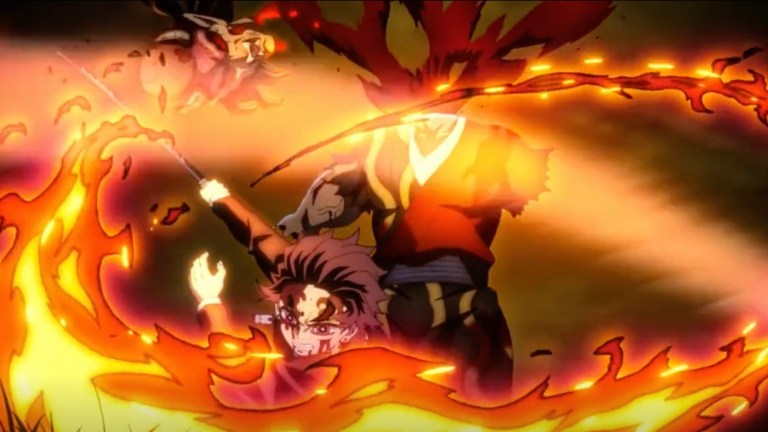Demon Slayer Season 3 Episode 11 Review – A Connected Bond: Daybreak and First Light
Demon Slayer's messy, drawn out third season ends on a promising note by focusing on Tanjiro and Nezuko's everlasting love.

This Demon Slayer review contains spoilers.
Demon Slayer Season 3 Episode 11
“Thank goodness, right?”
“Don’t run away from your responsibilities.”
Demon Slayer: Kimetsu no Yaiba’s third season finale, “A Connected Bond: Daybreak and First Light,” begins with a fiery threat from Tanjiro to Hantengu: “Don’t run away from your responsibilities.” This may seem like a silly order to command in the height of combat, but it’s the guiding force and larger theme that holds together this finale–and the season as a whole.
The importance of perseverance and never giving up is pretty par for the course with shonen protagonists and it’s hardly a groundbreaking revelation. That being said, it’s still enough to give focus to this finale’s many fighters, whether it’s Nezuko, Tokito, Tanjiro, or even Muzan Kibutsuji. “A Connected Bond: Daybreak and First Light” has its share of highs and lows, but it concludes this season with a satisfying finish that contains some of the most emotionally raw moments from the entire series.
Demon Slayer has never avoided the nitty gritty nature of its diverse demons, but “A Connected Bond: Daybreak and First Light” really deconstructs these monsters’ very existence and what they’re designed to do–eat and kill humans–and if it’s possible to transcend that purpose. Nezuko, for instance, is juxtaposed against the creator of all demons, Muzan Kibutsuji, whose similarities aren’t clear until the episode’s final act. It’s helpful to reframe the demon narrative and further pull back the curtain in a season that’s largely reduced demons to unstoppable killing machines.
On that note, the entire Swordsmith Village comes together to put an end to Hantengu in a tense race against daybreak. There’s some satisfying teamwork between Nezuko and Genya, not to mention some heartwarming cooperation between Tanjiro and Tokito where the former obtains the Mist Hashira’s sword as the final ingredient that’s necessary to end this season-long skirmish. Every swing of Tanjiro’s sword is beautifully animated and he taps into unprecedented power through channelling energy from every muscle and vein in his body into a single concentrated blow.
All of this makes for a stunning battle, but this is also what audiences should have been getting all season rather than this slow drip-feed approach to combat and storytelling. It’s a worthy display of Tanjiro’s power, yet in doing so it largely renders the rest of the season’s individual episodes as irrelevant. Demon Slayer fans will likely watch this finale dozens of times before season four, but there’s little incentive to revisit the water-treading events of any of this season’s middle installments.
The finale’s first act really highlights a rabid obsession in Tanjiro to do whatever it takes to execute Hantengu. Tanjiro does a lot of yelling and certainly looks angry, but this could have been a really interesting opportunity to push the show’s hero to a darker place where his Demon Slayer duties overpower common sense and decency. There are so many players in this final fight that it wouldn’t have been difficult for Tanjiro to neglect Genya and Tokito in exchange for Hantengu’s defeat and for them to wonder if he’s headed in the right direction or if his growing Demon Slayer abilities are actually something to worry about.
This finale doesn’t do anything nearly this interesting and it’s instead content to tease such developments while delivering what is, for all intents and purposes, a standard fight. It looks great, sure, but it’s nothing that wasn’t previously accomplished in past battles and there’s not even a reason that this finale needs to be super-sized at 52 minutes. A tighter finale would have left a greater impact than one that simply masquerades as being grandiose due to its extra length. There’s no reason that Demon Slayer’s Swordsmith Village saga couldn’t have just been a dense movie like Mugen Train.
There’s a lot that doesn’t work in this finale–and this season–but “A Connected Bond: Daybreak and First Light” truly comes alive in its second-half once it strips itself of all of its baggage and gets back to Demon Slayer’s original mission statement: Tanjiro’s desire to heal Nezuko and save his sister from a life of darkness. Tanjiro has previously had to make some difficult decisions, yet none of them have been nearly as impossible as what he faces when he needs to choose between his target and his sister.
There’s palpable tension during Tanjiro’s breakdown and it’s such a dramatically rich conflict that’s honestly equal to a harrowing decision that Walter White is forced to make in Breaking Bad’s second season. That may sound ludicrous, but Demon Slayer gets there. For all of this season’s faults and frustrations, it’s hard for anyone who has ever cared about this series and its characters to not get choked up over Tanjiro and Nezuko’s embrace. The few words that she shares with her brother convey greater pathos and growth than the entire season’s script.
Nezuko is practically bashful when she flippantly summarizes the events of this lengthy battle with, “Thank goodness, right?” Her words are an absolute understatement and yet they aptly describe the tone of this finale wherein everything magically works out. The same opportune luck is experienced when Mitsuri Kanroji declares, “Yay, I’m saved,” as her demon aggressor conveniently turns to ash right when she’s about to lose.
All of the heroes survive this ordeal, which functions as the inverse of Mugen Train or the Entertainment District’s conclusions, but it’s still somewhat disingenuous. Genya and Tokito both arrive at death’s door, but neither succumb to their injuries. That’s not to say that one of their demises would have improved this finale. However, there would be a greater sense of stakes and loss instead of the Swordsmith Village amounting to another pit stop on these Demon Slayers journeys.
Equally compelling to Nezuko’s sun-bathed epiphany is what this shift implies for Demon Slayer’s future. Nezuko has literally stayed in the shadows over the course of the series and she’s ready to face the harsh light of day in a way that’s set to make next season bloodier and more brutal than ever before. Demon Slayer’s use of flashbacks can be hit or miss, but this extended look into Muzan Kibutsuji and the Twelve Demon Moons origins is extremely effective and adds some welcome symmetry to the season, which begins in a similar manner.
Muzan’s time in the Heian Era includes some impressive visual flourishes from ufotable like how all of the blood that Muzan spills is the one piece of color in what’s otherwise a black-and-white flashback. It’s a powerful way to emphasize the birth of a tremendous evil that changes the shape of the world, like color invading greyscale darkness, even if it’s not the first anime to turn to such a visual tactic. The flashback’s similar treatment of Blue Spider Lily also establishes the significance of this medicine and that it’s the singular goal that drives Muzan forward. Nezuko has replaced that and that’s a very scary thought to consider as she acquires a massive target on her back for next season. It’s a smart way to build upon Tanjiro’s fear that he’ll lose his sister that becomes such an emotional force in this finale.
“A Connected Bond: Daybreak and First Light” ends Demon Slayer on the most promising note possible even if this is a finale that also highlights the season’s sloppy structure and pacing (remember Tanjiro’s mysterious connection to Tokito’s father? He certainly doesn’t). The highs of this finale are proof that Demon Slayer is far from a lost cause and has plenty of gas left in its tank, but this is also the perfect place for the anime’s production to regroup and remember what made this series a success in the first place. There are important lessons for Demon Slayer to learn from itself this season–not unlike Tanjiro’s own development as a Hashira–and under the right training both have the potential to return stronger and sharper than ever before.
If nothing else, Zenitsu and Inosuke will be out of the penalty box.
